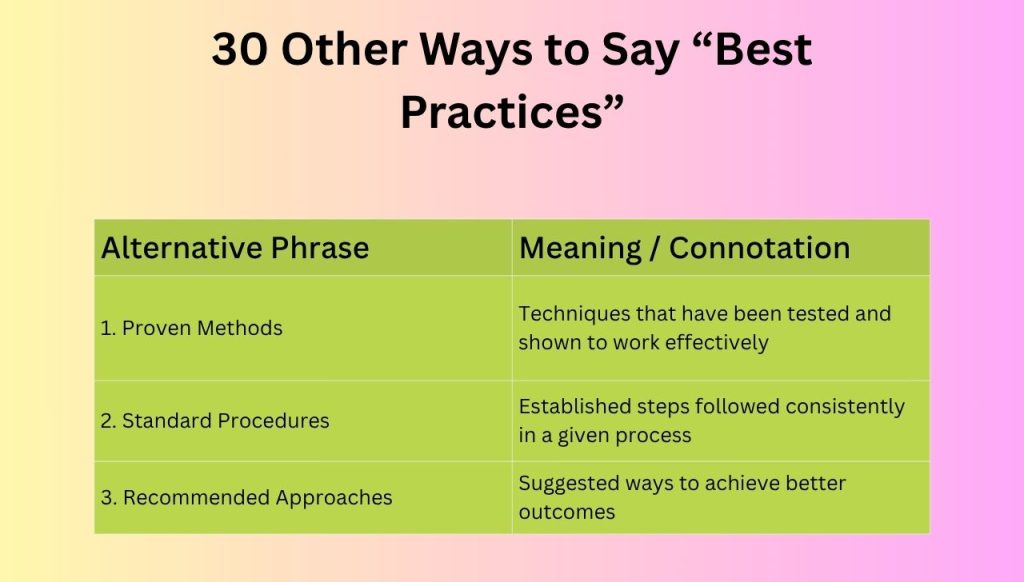Let’s face it—“best practices” is everywhere. Meetings, memos, strategy decks—you hear it tossed around like confetti. But after a while, it starts to feel… stale, right? It’s one of those phrases that lost its spark from overuse. And when words lose their punch, they also lose their power to persuade.
So what if you could say the same thing—without saying “best practices”? What if you could bring some personality, precision, or even a little flair into your language? Whether you’re a writer, marketer, manager, or just someone tired of corporate speak, we’ve got you. Let’s break down what “best practices” even means, when it makes sense to use it, and why you’d want to swap it out. Oh, and of course—we’ll give you 30 better ways to say it.
“Best Practices” Meaning
In short, it’s a set of methods or techniques that have proven to deliver good results. They’re repeatable, reliable, and often backed by experience or data. Think of them like tried-and-true roadmaps. People use them to avoid reinventing the wheel or falling into common traps.
In other words, it’s the business world’s way of saying, “We’ve done the homework, and this works.” But here’s the catch: it’s vague. It doesn’t say what works, why it works, or for whom. That’s where trouble starts.
Dive Deeper : 30 Other Ways to Say “Please Be Advised” (With Meaning, When & Why to Use It)

When to Use “Best Practices”
There is a time and place for the phrase.
- When you’re giving general guidance to a broad audience
- When the topic is industry-standard and universally accepted
- When clarity matters more than creativity
- When writing documentation, guides, or formal policy
- When you don’t want to sound experimental
For example, if you’re writing a manual for HR onboarding or outlining cybersecurity protocols, “best practices” can actually save time. Everyone knows what you mean—even if it’s a little dull.
But if you’re pitching to clients, writing a blog post, or trying to engage readers who’ve already seen the phrase 500 times this month? You might want to swap it out for something fresher or more specific.
Why Say Something Other Than “Best Practices”?
Language shapes perception. And generic language = generic impact. If you’re aiming to stand out, persuade, or show thought leadership, using clearer or more colorful phrases can go a long way.
Here’s why finding alternatives matters:
- It forces clarity: You’ll often land on a better phrase just by being more specific.
- It shows creativity: Clients and colleagues notice sharp writing.
- It avoids fluff: “Best practices” can feel like a placeholder when we don’t want to dig deeper.
- It builds trust: People trust what they understand. Concrete > corporate.
And honestly? It just feels better to write something that sounds like a person said it—not a policy manual.

30 Other Ways to Say “Best Practices”
| Alternative Phrase | Meaning / Connotation |
|---|---|
| 1. Proven Methods | Techniques that have been tested and shown to work effectively |
| 2. Standard Procedures | Established steps followed consistently in a given process |
| 3. Recommended Approaches | Suggested ways to achieve better outcomes |
| 4. Leading Strategies | Top or innovative methods used by leaders in the field |
| 5. Effective Techniques | Approaches known to produce desired results |
| 6. Established Guidelines | Rules or principles widely accepted and followed |
| 7. Preferred Methods | Commonly chosen practices for their reliability |
| 8. Industry Norms | Widely accepted standards within a particular industry |
| 9. Gold Standards | The highest quality or benchmark for excellence |
| 10. Time-Tested Solutions | Approaches that have stood the test of time |
| 11. Expert Recommendations | Suggestions given by experienced professionals |
| 12. Proven Tactics | Specific actions known to succeed in real-world settings |
| 13. Standard Operating Procedures | Documented routines used to carry out complex operations |
| 14. Performance Benchmarks | Criteria or examples used to measure excellence |
| 15. Model Practices | Practices held up as exemplary or ideal |
| 16. Accepted Protocols | Agreed-upon ways to conduct tasks or interactions |
| 17. Field-Tested Approaches | Methods that have been evaluated through real-life application |
| 18. Operational Standards | Rules or metrics used to guide operations consistently |
| 19. Optimal Techniques | Most efficient or effective ways to achieve results |
| 20. Recommended Standards | Endorsed rules or expectations for behavior or performance |
| 21. Quality Practices | Methods associated with producing high standards or excellence |
| 22. High-Impact Strategies | Approaches known to generate significant results |
| 23. Proven Workflows | Effective sequences of tasks used successfully before |
| 24. Professional Norms | Commonly accepted professional behaviors or practices |
| 25. Strategic Approaches | Long-term, goal-driven methods |
| 26. Core Competencies | Key strengths or essential skills/methods widely adopted |
| 27. Routine Procedures | Regularly followed actions that support consistency and efficiency |
| 28. Organizational Standards | Internal practices considered optimal by a specific company |
| 29. Effective Habits | Repeated actions that consistently yield positive results |
| 30. Smart Practices | Pragmatic and intelligent ways of doing things better |
Dive Deeper : 30 Other Ways to Say “Enjoy Your Weekend” (And When to Use Them)
Conclusion
The truth is, language evolves—and so should we. Reaching for sharper, fresher alternatives doesn’t just improve your writing; it elevates how people perceive your message. Whether you’re creating a newsletter, leading a team, or building a brand, how you say something matters almost as much as what you’re saying.
Next time you catch yourself typing “best practices,” stop for a second. Ask: What do I really mean here? Is it a method? A process? A standard? Then choose a phrase that brings that meaning to life. Because honestly? The phrase “best practices” might still work—but that doesn’t mean it’s your best option.

Grammar Nerd, ESL Trainer, Low-Key Comma Crusader
Daniel has taught English for over a decade, from small community classes in Oaxaca to bustling university halls in London. He has a knack for turning even the driest grammar points into relatable, real-life language tools—think fewer red pens, more real talk. He co-founded Grammation to make grammar less gatekeeper-y and more global. When he’s not decoding sentence structures, he’s probably hiking with a paperback novel or adding unnecessary hyphens for fun.
“The rules of grammar should empower people—not trip them up.”


